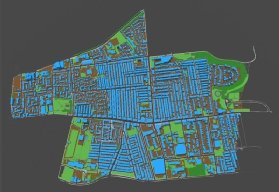
CGA Simulation
Liverpool health, social care and education 5G network expands
Europe’s largest 5G health and social care network infrastructure deploys range of IT and entertainment technologies in hybrid setup to increase reach of independent public sector network
Emerging technologies like digital twins, artificial intelligence and gaming visualisation have all contributed to a planning tool that’s helping Liverpool’s 5G Create project build a more comprehensive, larger and complex 5G health, social care and education network.
The Liverpool 5G Health and Social Care Testbed began operation in the Kensington area of Liverpool in April 2018, and the Liverpool 5G Create: Connecting Health and Social Care project, announced in August 2020, set out to develop a private, independent 5G network for health and social care services in selected areas of the city.
The network is designed to reduce digital poverty for vulnerable people in need, providing safe, free and accessible connectivity to services including health, social care and education. The project will increase the area covered, upgrade existing mmWave nodes, integrate small cell technology and trial a range of new use cases in health and social care.
The £7.2m project was funded by the UK’s Department for Culture Media and Sport (DCMS) as part of its 5G testbed and trials programme to show how effective 5G is at supporting different sectors in the UK – in this case, life-changing health, social care and education technologies.
The planning tool, designed by Liverpool tech company CGA Simulation, aims to save time and resources for projects planning a 5G network – such as 5G testbeds, local authorities and transport hubs, including train stations – and allow them to plan their network build online first.
The 5G network in Liverpool is said to be unique, as a hybrid 5G small cell public sector network of this scale hasn’t been attempted before. 5G-supported remote GP consultations, online wound management, a haptic (remote hug) shirt, care homes sensors, an anti-anxiety app for children under eight, and support for children learning at home during the Covid 19 pandemic are among the technologies being trialled by the community. The 5G connection to use these technologies is provided free to the community during the course of the project.
Given that a broad spectrum of technologies is being trialled, the project created a hybrid “network-of-networks” to ensure all of the technologies are properly supported. 5G mmWave technology, deployed by wireless networking equipment provider Blu Wireless, uses existing fibre to create a wireless mesh network, which forms the backbone of the 5G network in Kensington. This is aligned with a community LoRaWAN service, which supports internet of things (IoT) technologies. Telet Research’s Neutral Host small cell technology is currently being added to the network to provide user device access across the area.

Planning the network was said to be complicated and the planning tool used to bring it to life has proved an integral part of this ambitious build. “The tool creates a 3D digital copy of the network build area using local data from Ordnance Survey, local authority mapping and the Office of National Statistics to accurately access where houses, roads, lamp posts and street furniture are located – replicating these in a visual display,” said CGA managing director Jon Wetherall.
“Using the planning tool, we can analyse how a 5G connection penetrates through walls, and where 5G nodes should be placed to navigate around obstructions like trees,” he added.
This process saves time and money for planning teams, insisted Liverpool 5G’s technology lead, Andrew Miles. “The tool maps where on lamp posts, the side of buildings, or street furniture, the 5G nodes should be placed to communicate effectively – via line of sight. This reduces planning time as the hard work can be done online rather than by foot,” he said.
“It is a cost-effective, efficient and easy-to-use alternative for teams on a tight budget. The planning tool can also generate a ‘kit pack’ for planning teams, which lays out the exact technical parts needed to erect the working 5G network. They know exactly which parts to order and when,” he added.
Read more about UK 5G deployments
- Leading next-generation network test lab announces latest project offering a showcase for what the future of connected transport could look like in its home region and beyond.
- UK’s largest and busiest container port to test the potential of 5G across two use cases: enabling remotely controlled cranes and optimising predictive maintenance though IoT and AI.
- Harwell Campus 5G research facility gets financial boost to assist development of advanced communications for terrestrial and satellite-based broadband networks.








